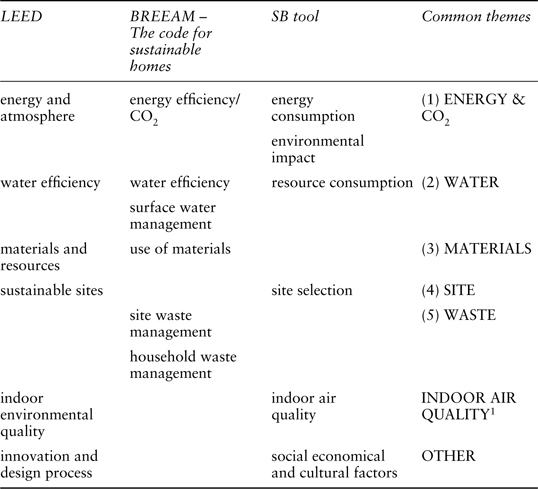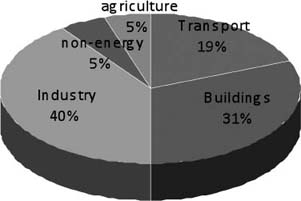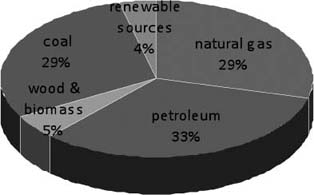Green buildings: a critical analysis of the Turkish legislation

Green buildings: a critical analysis of the Turkish legislation
5.1 Introduction
Green buildings are defined as resource-efficient and ecosystem-conscious structures designed with a holistic understanding of social and environmental responsibility, harmonious with local conditions, built with proper materials and systems so as to minimize energy consumption, where renewable energy sources are given priority and waste production held under control (Turkish Green Building Association, 2009). The notion of “green building” pertains to the whole life cycle of a building from site selection to demolition. Also variously designated as “ecological,” “environmentfriendly,” or “sustainable” buildings, green buildings have become one of the most important elements in the issue of sustainability, an issue inevitably highlighted by climate change and depletion of natural resources.
“Sustainable development” has been defined in a report by the United Nations–sponsored World Commission on Environment and Development (WCED) in 1987, as “development that meets the needs of the present without compromising the ability of future generations to meet their own needs” (WCED, 1987, p. 43). Unfortunately today, the construction, maintenance, and use of buildings transgress the principles of sustainable development and are currently contributing significantly to irreversible changes in the world’s climate, atmosphere, and ecosystem (Akbiyikli et al., 2009). Buildings are responsible for 30 percent of waste output, 39 percent of energy use, 38 percent of CO2 emissions, 72 percent of electricity consumption, 40 percent of raw material use, and 14 percent of potable water consumption (US Green Building Council, 2009). With the aim of addressing this harm, the concept of “green buildings” has gained recognition in the architecture, engineering, and construction (AEC) industry within the past decade and today the AEC industry is facing ever-increasing demand to improve its sustainability performance.
This paradigm shift also generated the need to develop norms and regulations for sustainable building design and construction. Today there is a well-developed green building certification practice and a diverse array of regulations regarding green buildings and sustainability in several countries. However, the results of research by Akbiyikli et al. (2009) show that the current level of sustainability understanding and hence its implementation is still unstructured, piecemeal, and insufficient in the Turkish AEC industry.
Besides the problems regarding energy and environment, with the joint effects of the Kyoto Protocol signed in February 2009 and the process of adopting related European Union statutes as an accession country, Turkey is on the verge of a revolution in “sustainability,” and in “energy efficiency” – a major prerequisite of sustainability. Climate change, the situation of energy resources in Turkey and in the world, alternative sources of energy, and energy efficiency technologies are at the top of Turkey’s agenda, together with green buildings and energy conservation in industry, transport, and buildings. The preparation of relevant legislation constitutes a decisive part of Turkey’s transformation process. In the last couple of years, Turkey has enacted an array of new primary and subordinate legislation on sustainability and energy efficiency issues that are compliant with the pertinent European Union legislation; yet, currently no specific legislation exists on green buildings. The Energy Efficiency Law promulgated in 2007, regulations and by-laws put into force in connection with it in 2008 and 2009, such as the Regulation on Energy Performance of Buildings and the National Building Energy Performance Calculation Methodology, are still being discussed among academicians and practitioners in Turkey in this context.
Following a general overview in the next section, of economy, legal system, energy and environment in Turkey, this study analyzes the current legislation in the framework of “green building themes” developed on the basis of performance criteria used in the green building certification systems. The final section draws attention to the deficiencies in policies and statutory regulation pertaining to green buildings and brings forth proposals for the promotion of green buildings in Turkey.
5.2 Country overview
5.2.1 Economy
Turkey is a founding member of the Organisation for Economic Cooperation and Development (OECD) and the G-20 major economies. The gross domestic product (GDP) growth rate from 2002 to 2008 averaged 6 percent (Turkish Statistical Institute, 2009), which made Turkey one of the fastest growing economies in the world. The International Monetary Fund (IMF) forecasts a GDP1 of 999 billion USD for Turkey in 2009 (International Monetary Fund, 2009) making her the fifteenth largest economy in the world.
The European Union (EU) accession process, particularly the Customs Union between Turkey and the EU Countries and the conclusion of the Uruguay Round are the main determinant factors shaping Turkey’s international trade policies and orientations (World Trade Organization, 1998). Key sectors of the Turkish economy are tourism, construction, banking, home appliances, electronics, textiles, oil refining, petrochemical products, food, mining, iron and steel, machine industry, and automotive.
The construction industry represents 6 percent of Turkey’s GDP by itself; together with all complementary and related industries, it accounts for 30 percent of the GDP (Turkish Contractors Association, 2009). The industry is divided into two parts: the lower-quality domestic-only set of firms and the higher-quality international firms (Katsarakis et al., 2007). On the lowerquality side, there are more than 30,000 active local firms, whereas 145 members of the Turkish Construction Association stand on the international side, 31 of which are among the 225 world’s largest construction companies in terms of overseas activities (Engineering News-Record, 2009). From 1972 to 2008, Turkish Contractors have undertaken almost 5,000 projects in 70 countries, with a combined value of 130 billion USD (Turkish Contractors Association, 2009). Currently, Turkish firms have a very strong presence in the Middle East, North Africa, Former Soviet Union, and Eastern Europe, and have started penetrating Western Europe.
This level of activity, particularly the international activity, places upon the Turkish construction cluster a responsibility to play a pivotal role in sustainable construction by effective protection of the environment and careful use of natural resources (Akbiyikli et al., 2009).
5.2.2 Legal system
The Turkish Law and legal system, compared to the Anglo-American Common Law, falls under the Civil Law tradition of continental Europe, based on statutory and legal enactments. The Swiss Civil Code and Code of Civil Procedure, Italian Penal Code, German Code of Criminal Procedure and Code of Commerce, and French Administrative Law were adopted with due adaptations some ninety years ago by the new Turkish Republic (Orucu, 2000). Substantial amendments and modifications have been effected since, particularly in the last decade within the framework of the EU accession process.
5.2.3 Energy and environment
Turkey is a country of 814,000 km2 having a population of over 70 million. Turkey’s territory lies where the three continents making up the old world (Europe, Asia, and Africa) are closest to each other, and where Europe and Asia are separated by the Bosphorus. Turkey’s neighbors to the west are Greece and Bulgaria, and to the east Georgia, Armenia, Syria, and the energy-rich Iraq and Iran. In spite of its possession of some limited energy resources, Turkey has to import a greater part of the energy it consumes. Meeting the energy demand by domestic production decreased from 48.1 percent in 1990 to 26.9 percent in 2006 (Ministry of Energy and Natural Resources, 2009). Turkey has to continue its ever-increasing energy import to keep up with its rapidly growing energy deficit. In this sense, the steps Turkey will take to foster energy efficiency are paramount in their prospective contribution to the national economy. Figure 5.1 shows the distribution of energy consumption among various sectors.
Figure 5.1 Distribution of energy consumption among various sectors in Turkey

Source: Adapted from the Ministry of Energy and Natural Resources, 2009.
Within the total energy consumption, industry has a share of 40 percent, domestic consumption (in households) 31 percent, transportation 19 percent, and agriculture 5 percent (Ministry of Energy and Natural Resources, 2009). The relatively high share of domestic consumption points to its relative importance as an issue in the management of the energy deficit. Decreasing the share of domestic consumption through efficient use of energy according to green building principles is likely to be an effective remedy in decreasing Turkey’s total energy consumption and therefore its dependence on energy imports. Distribution of primary energy consumption among various sources is given in Figure 5.2 (Ministry of Energy and Natural Resources, 2009).
Figure 5.2 Distribution of primary energy consumption among various sources

Source: Adapted from the Ministry of Energy and Natural Resources, 2009.
The relatively large share of fossil fuels in meeting Turkey’s energy demand poses a problem with respect to environmental sustainability, not only because the fossil fuels pollute the environment, but also because they cannot be replenished. A large part of CO2 emissions in Turkey originates from domestic use of fossil fuels. This makes buildings one of the highest contributors to the greenhouse gas emissions that cause climate change, as well as one of the biggest opportunities to reduce these emissions (Erten, 2009).
All in all, the energy-related figures show clearly that even incremental improvements in domestic energy consumption would yield considerable benefits as to sustainability in both economic and environmental capacities. Although transition from coal to natural gas as fuel for the heating of houses in large towns has been a favorable move from an environmental standpoint, boosting efficiency in the use of energy via green building principles has already become an urgent necessity under the current circumstances.
5.3 Analysis of the current legislation
In addition to the internal factors of energy and environment issues, the external factors of ratifying the Kyoto Protocol and the European Union acquis, which Turkey as an accession country is in the process of adopting, have all served to thrust Turkey forward in developing the legislation on sustainability. This is why the analysis of existing regulations commences in this section with a review of the related international treaties.
5.3.1 International treaties
(A) Adoption of the EU acquis
Turkey was officially recognized as a candidate state on an equal footing with the other candidate states at the Helsinki European Council held on 10–11 December 1999. At the end of 2004, the accession negotiations between the EU and Turkey were formally started, initiating a formalized process whereby Turkey is required to complete the adoption of the EU acquis. Turkey administers its adoption of the EU acquis according to a “National Program” which furnishes a road-map for adaptation of the legislation. The last National Program prepared in 2008 (Secretariat General for EU Affairs, 2009) includes issues regarding the purpose of energy efficiency in buildings. As stated in the National Program, the Regulation on the Energy Performance of Buildings, predicated on the EC Directive on the Energy Performance of Buildings,2 was promulgated in December 2008. Formulation of the Building Energy Performance Calculation Methodology and development of its software were completed in December 2009. According to the National Program, the following actions will be completed in 2010 in order to support the implementation of this regulation:
• Strengthening of the administrative capacity for implementation of the Regulation.
• Establishment of a laboratory in order to carry out the activities such as R&D, inspection and training regarding the energy performance of buildings.
• Establishment of a “Building Inventory” database for effective implementation of the Regulation.
• Design training courses for the building constructors on ecologic construction, solar energy, zero CO2 emission buildings and construction techniques for energy efficient buildings.
(B) Kyoto Protocol
Turkey became a party to the United Nations Framework Convention on Climate Change (UNFCCC) in 2004 but refrained from signing the Kyoto Protocol for a prolonged period. On February 5, 2009 a law of conformity numbered 5836 was enacted and the protocol was signed on May 7, 2009. With this Protocol, Turkey has accepted to promote sustainable development,3 enhance energy efficiency in relevant sectors of the national economy,4 research on and promote development and increased use of new and renewable forms of energy, of carbon dioxide sequestration technologies and of advanced and innovative environmentally sound technologies5, encourage appropriate reforms in relevant sectors aimed at promoting policies and measures which limit or reduce emissions of greenhouse gases,6 and ensure that emissions of the greenhouse gases do not exceed the assigned amounts, calculated pursuant to the quantified emission limitation and reduction commitments.7 Undoubtedly, promoting greener buildings is a very effective and indispensable way of achieving these commitments. Below is the analysis of the current national legislation regarding common green building themes, most of which have been promulgated in the last five years.
5.3.2 National legislation
Turkey is one of the few countries that included environmental protection in its Constitution. According to the Constitution,8 everyone has the right to live in a healthy, balanced environment. It is the duty of the state and citizens to improve the natural environment and to prevent environmental pollution. Despite this provision, no specific legislation exists in Turkey currently on green buildings; therefore, a conceptual framework has been developed for reviewing the current legal situation. In this framework, the performance criteria contained in the green building evaluation systems used worldwide (Leadership in Energy and Environmental Design (LEED), Building Research Establishment Environmental Assessment Method (BREEAM) and Sustainable Building Tool (SBTool)) have been categorized and common themes relevant to green buildings were determined. Laws and regulations falling under the scope of each theme are dealt with below, also with an eye to identifying the need for new legislation.
Table 5.1 Common themes for analysing legislation regarding the green buildings

1 “Indoor air quality” is analysed within the “Energy” theme.
The building industry is responsible for a large part of the world’s environmental degradation as buildings converge in themselves major indexes of energy and water consumption, raw material employment, and usage of land (Melchert, 2007). This is why use of natural resources like energy, water, land, and raw materials is among important criteria employed in assessment systems for green buildings. On the other hand, buildings generate considerable quantities of waste during their construction, utilization, and demolition, a fact that makes waste management control another crucial theme associated with green buildings.
(A) Energy
Energy efficiency is defined as minimization of energy consumption without compromising either the quantity or the quality of production, nor entailing any impairment in economic growth or degradation in social welfare (Olgun et al., 2009). Legal regulation has recently been made in Turkey with the purpose of stimulating energy conservation, rendering some practices compulsory and enabling inspection of obtained results. These legal measures are as follows:
(A) ENERGY EFFICIENCY LAW
Law 5627 of 2 May 2007 targets increasing the energy resources and the efficiency in the utilization of energy with the purpose of protecting the environment, the effective utilization of energy, cutting energy wastage, and relieving the burden of energy costs on the economy.9 Industrial plants, electrical energy production facilities, transmission and distribution networks, and transportation are within the purview of this Law, in addition to households.10 The Law describes the scope of tasks and authority for the institutions and agencies involved in the conservation of energy11 and regulates the education and consciousness-raising activities for augmenting the effectiveness of energy efficiency services and the energy consciousness.12 In order that measures are devised to improve energy efficiency in industrial plants, service buildings, public buildings, and commercial buildings with total construction areas of 20,000 m2 or more, this Law has made employment or outsourcing of certified energy managers mandatory.13 Whereas residential buildings are not under an obligation to employ energy managers, the principles of energy performance requirements for such buildings are stipulated to conform to “The Regulation for Energy Performance of Buildings.” Within the scope of the Law, subsidies to be granted to research and development and implementation projects have been formulated,14 as well as cases requiring imposition of administrative sanctions.15 Secondary legislation based on this Law, aiming at the improvement of building energy performance is as follows.
(B) REGULATION ON EFFICIENT USE OF ENERGY AND ENERGY SOURCES
Regulation 27035 of October 25, 2008 covers various details related to the implementation of issues like energy management, energy inspection, efficiency improvement projects, education and certification, authorization of agencies and companies as associated with these issues, and incentives for efficiency improvement projects.
(C) REGULATION ON ENERGY PERFORMANCE OF BUILDINGS (BEP-Y)
Regulation 27075 of December 5, 2008, also based on the Energy Efficiency Law no. 5627 of May 2, 2007, covers the computational rules for the assessment of all energy uses in a building, and its classification with respect to primary energy use and CO2 emission, the specification of minimum energy performance requirements for new or substantially renovated buildings, guidelines for the evaluation of the practicability of renewable energy sources, inspection of heating and cooling systems, abatement of greenhouse gas emissions, and the performance criteria and the implementation guidelines that apply to the buildings.16